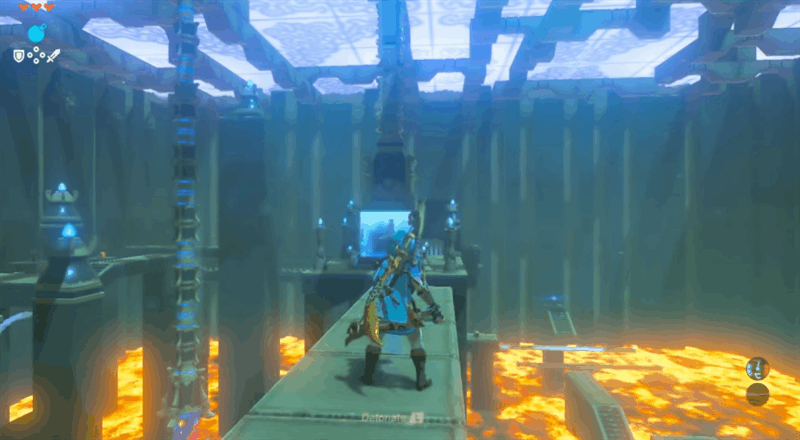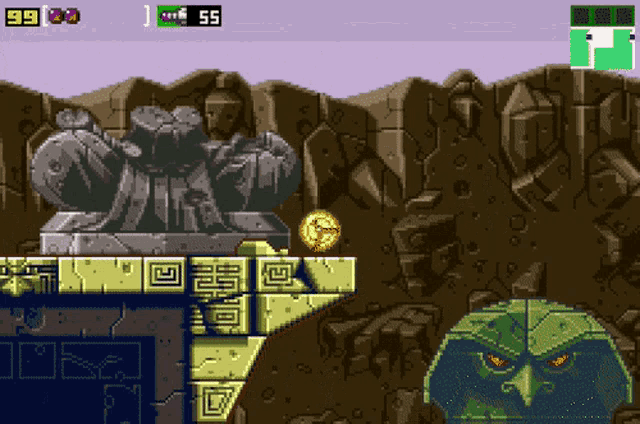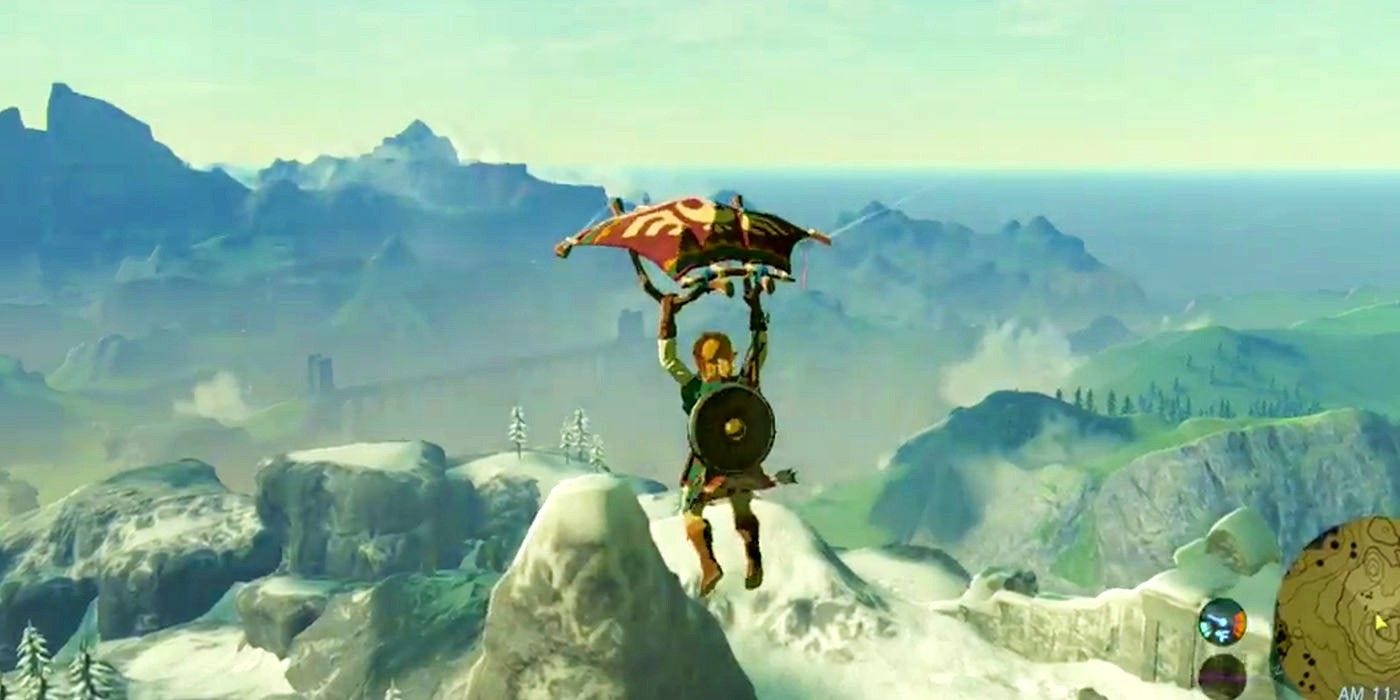How much does Flexibility Matter in BotW?
Examining the game's unparalleled reputation for 'player expression.'
Dabbling in Breath of the Wild’s postgame this week - picking an area of the map that I don’t recall scouring too closely, striking out, finding new shrines and korok seeds. My favorite shrine discovery of this late-game period has been the ‘Blue Flame’ shrine hidden in the area surrounding Death Mountain.
Today I want to talk about the game’s reputation for being unusually flexible in how players may approach it, solve problems, and achieve goals.
Five years into the game’s critical reputation and revitalization of the Zelda franchise (which was never exactly ‘struggling’ but which did go through a consensus-rough-patch beforehand, roughly 2007-2011), it’s almost become a cliche to talk about how Breath of the Wild deftly avoids ‘right answer’ gameplay. Put another way, you’ll often hear fans say things like, “watch five players complete the same shrine, and you may see five substantially different thought processes and solutions.” Experienced players may recommend different orders for the game’s four Divine Beasts as well… I know I’ve come across the idea that Mipha’s Grace is intended as your first Divine Ability, but I obtained it last and, in the context of my own journey through the game, last seemed exactly right.
Players may respond differently to the ‘harsh elements’ in the game - the arid desert or frigid peaks. If you’re sprinting for an objective in one of these climes, but otherwise unprepared, it’s reasonable to just ‘tank’ damage and heal up by consuming food, transforming the game from its usual state of abundance into something resembling a rugged survival experience. It still works. Maybe you have the right clothing. Maybe you’ve discovered recipes that give you immunity for long stretches. Or maybe - my favorite - you’ve discovered that wielding the appropriate elemental weapon keeps Link warm or cools him down (equip a Great Frostblade with the Gerudo sun beating down on you, and Link soldiers on).
Maybe, as I did, you feel an intuitive response to the game’s ‘verticality,’ and re-center navigation and routing all around height. But maybe not - maybe you love shield-surfing and begin to look at smoothness and slopes. Maybe you’re especially attached to animal taming and begin to see the game more through a lens of acquiring and summoning and caring for mounts. These things all require a degree of mental commitment. It’s not trivial to set up Link for frequent paraglider launches, etc. You have to follow a preference and develop an affinity. Almost any other game with these mechanics for taming horses would rapidly converge on a norm where you always had your horse. But here it’s an option you could gravitate toward, or not.
There’s an infamous shrine in Breath of the Wild where you need to use motion controls to navigate a ball through a maze. At first, it seems exceedingly fussy and almost inescapably irritating. But after only a couple of attempts, it dawned on me that I had “real” or “full” control of the maze, meaning that not only could I adjust it a bit this way and a bit that way, I could flip it over. Underneath, there’s no maze at all, only a flat surface. And once the ball falls out of the maze, the game drops a new one in from above. I would almost say that this is the “intended” answer or lesson in this case - creating something that feels almost like deliberate trolling at first, but with the built-in reminder that you can just ‘go around.’ Most of the game lacks the stark contrast of this shrine, but retains the freedom that it teaches you to look for.
In one shrine, I observed a rather complicated set-up to delay a ball rolling into its slot, which would activate an elevator I needed to be standing on. So the name of the game was delay - set the ball in motion but give yourself time to get in position. The room contained various moving platforms and I’m sure there was a more ‘Rube Goldberg’ way of doing it. But just in that more personal and intuitive moment, I realized I could place a big metal cube right on the activation basin, drop the ball next to the cube, and it would take several seconds for the ball to gradually roll around into position. So I skipped any larger puzzle altogether - instead I understood “I need to buy myself a few seconds here” and thought “well can’t I just…”
And I could.
Breath of the Wild even includes mechanics that are ‘hidden in plain sight’ or would be more explicitly foregrounded in other games. Does link ever learn a “double jump” or does the game ever emphasize that he has one? Not exactly. But to begin shield surfing, you jump and then enter a second forward flip to land on your shield. The game literally never says “hey, hey, see this? See this extra flip you are doing?” But it’s there, and it can be used as its own tool simply to cross slightly longer gaps. The effect is small and it’s not something you use everywhere. But it can make a big difference if you ‘see it’ in the right situation. Nintendo has been doing this sort of thing for a long time - the ‘hidden double jump’ in Breath of the Wild reminds me of bomb-jumping in the early Metroid games. It’s a logical implication of existing mechanics, lets you creatively solve problems, but isn’t ever officially recognized by or within the game.
The question today is: how much does any of this matter? Bringing up an ancient bit of game design like Metroid bomb-jumping helps put the question in perspective. Fans and critics gush over Breath of the Wild’s latitude, its holistic design vision that allows players to try ideas and feel confident that they will work. Rather than carefully policing and funneling what you can do, Breath of the Wild creates rules within which it doesn’t care what you’re able to do.
I’ll join the chorus of praise. Player creativity is important. Allowing space for it is important.
But (could you tell there was a ‘but?’), the conversation around Breath of the Wild seems to imply at least one thing that is, I would say, flatly wrong, and also seems to shy away from exploring how Breath of the Wild is able to achieve its openness.
To the first: “one right answer” gameplay remains rare across all sorts of games and in all sorts of genres. But players complaining that they have to do things a certain way remains common. In other words, it’s been my experience that players can be quick to judge games during moments of frustration, during temporary failures, when overcoming obstacles, etc. Encountering resistance can trigger exaggerated venting and assuage egos: “well, clearly the game wants me to do this specific unfun or tedious or badly designed thing I don’t want to do.” And that’s often, but not always, total nonsense - it’s a self-indulgent reflex that puts you above the game, that casts you as smarter than the developers, that sees you as the ideal player who is beset by obviously-flawed games. Some games are bad and some game design is idiotic, sure. But momentary failure in games can produce a learned, cascading response where the only thing that matters emotionally is restoring your feeling that you are better than the feedback you are getting from the game (for people closer to my age: this is also why kids used to say things like “the game is cheating”).
Or, in short: the impulse to dismiss a game for being too narrow must be taken with a grain of salt. The conclusion, itself, should be one players grow to resist. Breath of the Wild offers an invigorating sense of breadth and possibility and validation. That’s real. But the reaction to it risks being, shall we say, out of proportion. The game is incrementally more ‘free’ than most. It is not categorically more so, does not ‘revolutionize’ player expression. It’s seductive, and from a branding/marketing standpoint, invites being romanticized. But a lot of games invite player expression and may be explicit to varying degrees about how they do that. And a lot of player expression is something that players learn to bring into games, not something that games simply grant as a privilege to players.
I enjoy this dimension of Breath of the Wild. But I would hold at arm’s length the notion that Breath of the Wild is ‘saving the day.’
To the second point - there’s some discussion to be had about whether Breath of the Wild pays a price for its more flexible and open-ended mechanics. Just about everyone has noted that the game’s shrines are, ultimately, a poor substitute for traditional & meaty Zelda dungeons. Just about any Zelda game includes masterfully intricate and conceptually robust dungeons - heady peaks that leave a lasting impression. The Shrines in BotW may be enjoyed on their own but can’t really compete with or replace what full-fledged dungeons and temples offered. The Divine Beasts are no different - practically speaking they’re indistinguishable from 4-5 Shrines being put in one environment to be completed in one sitting, and that’s not what a Zelda dungeon is.
Breath of the Wild is hardly the only place you’ll find this sort of ‘exploded’ game design, this continuous stream of light-bulb moments, endless micro-dosing. Contemporary game design owes an uncomfortable debt to the psychology of addiction and Nintendo is neither alone in leaning into that, nor were they even a pioneer in doing so (they do seem to be ‘all in’ for the time being - Super Mario Odyssey, in its own way, feeds the player endless tiny triumphs).
An unasked question: how much does the open-ended-ness of Breath of the Wild depend on the brevity and limitations of its individual challenges? It’s an unflattering train of thought. Does the game’s breadth of approach partially depend on content that is… shallow? To use a cliche, is Breath of the Wild “a mile wide but an inch deep?”
That would be taking things a bit far. Calling Breath of the Wild ‘an inch deep’ falls apart quickly from just about any perspective. But as a more targeted assessment of, for example, the shrines? There may be some truth to it. Despite the game offering a huge number of individual shrines, they present almost no curve in terms of difficulty or complexity (even for things like the “Tests of Strength” - I completed my first “Major Test of Strength” before my first Blight, and any minor/moderate test truly felt like an afterthought). Part of that goes back to player freedom to discover them in almost any order following the Great Plateau. But keeping the Shrines within a narrow band of complexity also diminishes the praise of players completing them in different ways. What you’re being asked to do isn’t very involved, so it should be less surprising that things just occur to players and work, as they are covering pretty short mental distances. I admire the design of Link’s toolset. But I do wonder - if this game included anything with the depth of a traditional Zelda dungeon, what would happen?
So, food for thought:
The true-believer praise for Breath of the Wild’s flexibility & player expression arguably exaggerates whatever the ‘narrow norm’ is supposed to be, and also glosses over the ceiling on any given puzzle or challenge in Breath of the Wild itself.
There’s a whole related question of accessibility, and whether Breath of the Wild draws in novices more successfully than most games. It might! But I’m generally of the opinion that newer gamers stumbling into meaningful early experiences is about 80% a matter of circumstance, and 20% a matter of game design. Longtime gamers resist that idea both because they want to think their own formative games are especially significant and, even more than that, they want to be able to identify games they can give to their partners, friends, etc that will open up new worlds for them. It’s probably never going to be that simple.
But that, I think, is a post for another day.





I probably need to watch a play through of BotW at some point (Since I don't own a Switch). I hadn't realized I'd been missing such a big conversation.